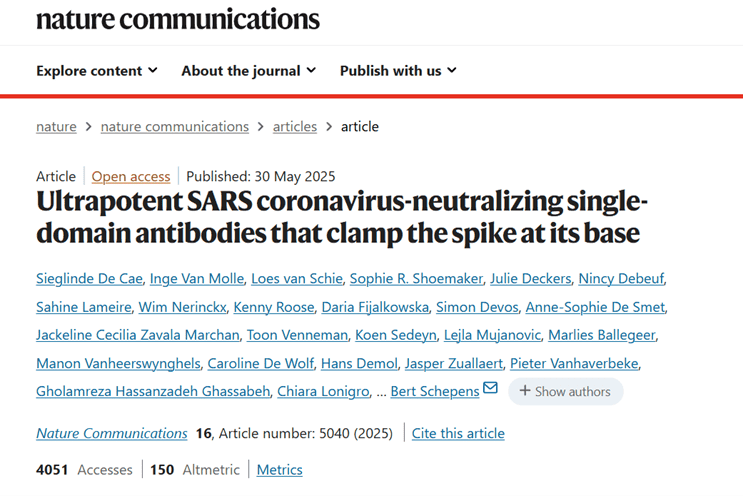In May, multiple breakthrough studies supported by abinScience, focusing on antibody and protein research, were published in top-tier journals such as Nature Communications and Chemical Engineering Journal. These studies span cutting-edge fields including cancer biomarker detection, antiviral nanobody development, and rapid diagnostics for infectious diseases. We are thrilled to see that some of these achievements were made possible by abinScience’s high-quality protein and antibody products. In this literature digest, we highlight several standout research advancements. Join us in exploring these latest scientific breakthroughs and their impact on biotechnology and healthcare!
Title: Ultrapotent SARS coronavirus-neutralizing single-domain antibodies that clamp the spike at its base
Journal: Nature Communications
Impact Factor: 14.7
Author Affiliation: VIB Center for Medical Biotechnology

The continuous mutation of SARS-CoV-2 has rendered existing monoclonal antibody therapies ineffective, creating an urgent need for broad-spectrum antiviral strategies effective against multiple variants. This study developed a set of single-domain antibodies (VHHs) targeting the highly conserved HR2 region of the S2 subunit of SARS-CoV-1 and SARS-CoV-2 spike proteins. These antibodies block viral membrane fusion by locking the HR2 in its pre-fusion conformation, demonstrating ultrapotent neutralizing activity against variants including BA.4, BA.5, and XBB. Notably, VHH R3DC23 prevented infection in animal models at low doses with minimal escape by variants, laying the foundation for broad-spectrum anti-coronavirus biologics and informing antibody design for other Class I fusion proteins.
abinScience provided biosimilars of Sotrovimab (Catalog No. VK565076), Cilgavimab (Catalog No. VK565026), and Bebtelovimab (Catalog No. VK565196) used as controls in experiments to validate the neutralizing capacity of VHHs against SARS-CoV-2 variants. The high purity of abinScience products ensured experimental reliability and reproducibility, providing critical support for evaluating the broad-spectrum neutralizing effects of VHHs.
Title: Ultrasensitive electrochemical biosensor for the simultaneous detection of the two monkeypox virus antigens M1R and A29 using reduced graphene oxide-ZIF-8 nanocomposite
Journal: Chemical Engineering Journal
Impact Factor: 13.3
Author Affiliation: Khalifa University of Science and Technology

Monkeypox virus (MPXV), a global public health emergency, lacks rapid diagnostic tools suitable for resource-limited settings. This study developed an electrochemical biosensor based on reduced graphene oxide (rGO) and ZIF-8 nanocomposites for simultaneous detection of MPXV antigens M1R and A29. Leveraging the high surface area and excellent conductivity of rGO-ZIF-8, combined with monoclonal antibodies, the sensor achieves a wide detection range from 1 pg/mL to 10 µg/mL, with limits of detection of 5.1 pg/mL for A29 and 3.4 pg/mL for M1R. The sensor demonstrates high sensitivity, specificity, and no cross-reactivity, with recovery rates of 90–105%, comparable to ELISA, making it ideal for field diagnostics in resource-limited environments and providing a reliable tool for early MPXV diagnosis and outbreak control.
abinScience provided M1R monoclonal antibody (SAA0284) (Catalog No. VK785023), M1R protein (Catalog No. VK785011), and M1R ELISA kit (Catalog No. AK785018) for constructing and validating the electrochemical biosensor. The M1R antibody was immobilized on the sensor surface to specifically capture M1R antigens, the M1R protein served as a standard for calibration, and the ELISA kit was used as a control method to validate sensor performance, ensuring the reliability and accuracy of the results.
Title: Development and Application of Highly Sensitive Protein Sensor Based on Spatial Conformation of Sodium Alginate Gel-Stabilized HE4
Journal: Microchemical Journal
Impact Factor: 4.9
Author Affiliation: Guilin University of Technology

Ovarian cancer often poses a life-threatening risk due to challenges in early diagnosis, necessitating precise and cost-effective methods to detect human epididymis protein 4 (HE4), a key biomarker. This study innovatively developed a highly sensitive electrochemical sensor based on sodium alginate (SA) gel for ultra-trace detection of HE4. Unlike traditional methods like ELISA, which are costly and susceptible to environmental interference, this sensor utilizes SA gel formed under calcium ion induction to create a three-dimensional cavity highly compatible with HE4’s molecular structure, significantly enhancing stability and selectivity. Experimental results show that the HE4@SA-gel sensor exhibits a linear response in the HE4 concentration range of 1.00×10⁻¹³ to 3.00×10⁻⁹ mol/L, with a detection limit of 2.37×10⁻¹⁴ mol/L, a sensitivity 12.7 times higher than non-gel sensors, and a selectivity 11.36 times greater, achieving recovery rates of 92.4%–106.7% in human serum samples, offering a powerful tool for early cancer screening.
abinScience provided HE4 (Catalog No. HC595011) and neuron-specific enolase (NSE) (Catalog No. HY438012) reagents. HE4 was used as the target biomarker to construct and validate the sensor’s specific detection capabilities, while NSE served as an interferent to test the sensor’s selectivity and anti-interference performance. These high-quality reagents provided critical support for the experiment's accuracy and reliability.
Literature Citation Reward Program
To express gratitude for the support and trust of researchers, abinScience is launching a Literature Citation Reward Program! Whether you're a pioneer in life sciences or a dedicated laboratory researcher, you can apply for generous rewards by publishing articles in SCI journals using abinScience's full range of products.

 中文
中文 English
English





